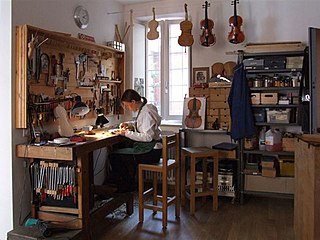Related Research Articles

A luthier is a craftsperson who builds or repairs string instruments that have a neck and a sound box. The word "luthier" is originally French and comes from the French word for lute. The term was originally used for makers of lutes, but it came to be used already in French for makers of most bowed and plucked stringed instruments such as members of the violin family and guitars. Luthiers, however, do not make harps or pianos; these require different skills and construction methods because their strings are secured to a frame.

Antonio Campi was an Italian painter of the Renaissance.

Bernadino Campi (1522–1591) was a Renaissance painter from Cremona, who worked in Reggio Emilia. He is known as one of the teachers of Sofonisba Anguissola and of Giovanni Battista Trotti. In Cremona, his extended family owned the main artistic studios. Giulio Campi and Antonio Campi, half-brothers, were distant relatives of Bernardino; the latter is generally considered the most talented of the family. All were active and prominent painters locally. Influences on Bernardino include local Cremonese such as Camillo Boccaccino and artists from neighboring regions such as Correggio, Parmigianino and Giulio Romano.
Francesco Rugeri, also known as Ruger, Rugier, Rugeri, Ruggeri, Ruggieri, Ruggerius, was the first of an important family of luthiers, the Casa Rugeri in Cremona, Italy. His instruments are masterfully constructed. His violins are inspired by Nicolò Amati's "Grand Amati" pattern. Francesco was the first to develop a smaller cello design, which has become the standard for modern cello dimensions. Today, Rugeri's instruments are nearly as renowned as Nicolò Amati's instruments.

Galeazzo Campi was an Italian painter of the Renaissance from Cremona in Lombardy. He was a pupil of Boccaccio Boccaccini. His representation was rather rigid, but careful. His landscapes show influences of Perugino and Giovanni Bellini.

Giovanni Battista Trotti was an Italian painter of the late-Renaissance period, active mainly in Piacenza, Parma, and his native city of Cremona.
Antonio Beltrami (1724–1784) was an Italian painter active in the late-Baroque and Neoclassic periods. He was born in Cremona. He was a pupil of Francesco Boccaccino, who emerged from the school of Carlo Maratta. His older brother, Giovanni Battista was an engraver.
Francesco Antonio Caneti (1652–1721) was an Italian miniature painter of the Baroque period. He was born at Cremona, where he was a pupil of Giovanni Battista Natali. He afterwards became a Capuchin friar.
Euclide Trotti was an Italian painter of the Renaissance period. He was born in Cremona and lived in the 16th century. He was the nephew and pupil of Giovanni Battista Trotti. He painted for the church of San Sigismondo at Cremona. An Ascension in S. Antonio at Milan is also attributed to him. He died young in prison, where he was confined on a charge of high treason.

Giovanni Battista Tortiroli (1621-1651) was an Italian painter of the Baroque period.
Giuseppe Giovanni Battista Guarneri, better known as Giuseppe filius Andrea Guarneri was a violin maker from the prominent Guarneri family of luthiers who lived in Cremona, Italy.
Giovanni Battista Ceruti (1756–1817) was an Italian violin maker, and is considered a direct link to the grand tradition of the Cremonese master violin makers of the 18th century. He known for his violins, cellos and double basses.

Giacomo Guerrini was an Italian painter of the late-Baroque period, active mainly in his natal city of Cremona. Giacomo Guerrini was also the original name of Mino Guerrini, a twentieth century media figure.

Galeazzo Ghidoni or Gidoni was an Italian painter.
San Girolamo is a 17th-century, Baroque style, Roman Catholic church on Via Sicardo 5, in Cremona, region of Lombardy, Italy. It is also known as the Oratory of San Girolamo.
Antonio Maria Panni was an Italian painter and art historian. He collaborated in a number of quadratura projects with Giovanni Battista Zaist, including the church of San Girolamo in Cremona. He also provided engravings for Zaist's 1774 Notizie istoriche de' pittori, scultori, ed architetti cremonesi. He also authored a monograph titled Distinto rapporto delle dipinture, che trovansi nelle chiese della città e sobborghi di Cremona, published in Cremona in 1762.

Andrea Mainardi, also known as il Chiaveghino, was an Italian painter of the late-Renaissance period, active in Cremona.
Carlo Natali, also known as il Guardolino, was an Italian painter of the Baroque period, active in Cremona and Bologna
Santa Rita is an ancient Roman Catholic church in Cremona, Italy. While it had been initially dedicated to the saints Margherita and Pelagia; since being reconsecrated in 1929 on May 22, the day devoted to St Rita of Cascia, the church has been affiliated with the latter saint.
Francesco Gialdisi was an Italian painter, born in Parma but active mainly in Cremona. There is little biographical information available.
References
- ↑ Notizie istoriche de' pittori, scultori ed architetti Cremonesi, Volume 2, by Giovanni Battista Zaist and Anton'Maria Panni], page 70.